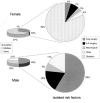Risk factors in acquired faecal incontinence
- PMID: 14996955
- PMCID: PMC1079318
- DOI: 10.1177/014107680409700303
Risk factors in acquired faecal incontinence
Abstract
Acquired faecal incontinence arising in the non-elderly population is a common and often devastating condition. We conducted a retrospective cohort analysis in 629 patients (475 female) referred to a tertiary centre, to determine the relative importance of individual risk factors in the development of faecal incontinence, as demonstrated by abnormal results on physiological testing. Potential risk factors were identified in all but 6% of patients (7 female, 32 male). In women, the principal risk factor was childbirth (91%), and in most cases at least one vaginal delivery had met with complications such as perineal injury or the need for forceps delivery. Of the males, half had undergone anal surgery and this was the only identified risk factor in 59%. In many instances, assignment of cause was hampered by a long interval between the supposed precipitating event and the development of symptoms. Abnormalities of anorectal physiology were identified in 76% of males and 96% of females (in whom they were more commonly multiple). These findings add to evidence that occult damage to the continence mechanism, especially through vaginal delivery and anal surgery, can result in subsequent faecal incontinence, sometimes after an interval of many years.
Figures




References
-
- Leigh RJ, Turnberg LA. Faecal incontinence: the unvoiced symptom. Lancet 1982;i: 1349–51 - PubMed
-
- Walter S, Hallbook O, Gotthard R, Bergmark M, Sjodahl R. A population-based study on bowel habits in a Swedish community: prevalence of faecal incontinence and constipation. Scand J Gastroenterol 2002;37: 911–16 - PubMed
-
- Perry S, Shaw C, Assassa P, et al. An epidemiological study to establish the prevalence of urinary symptoms and felt need in the community: the Leicestershire MRC Incontinence Study. Leicestershire MRC Incontinence Study Team. J Publ Health Med 2000;22: 427–34 - PubMed
-
- Department of Health. Good Practice in Continence Services. London: DoH, 2000
MeSH terms
LinkOut - more resources
Full Text Sources
Medical
Miscellaneous

